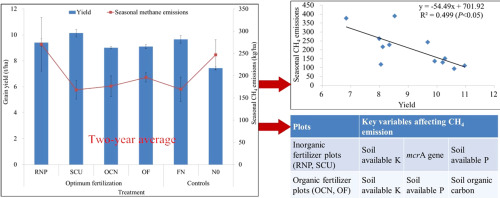当前位置:
X-MOL 学术
›
Sci. Total Environ.
›
论文详情
Our official English website, www.x-mol.net, welcomes your
feedback! (Note: you will need to create a separate account there.)
Effect of long term fertilization management strategies on methane emissions and rice yield.
Science of the Total Environment ( IF 8.2 ) Pub Date : 2020-03-27 , DOI: 10.1016/j.scitotenv.2020.138261 Pengfu Hou 1 , Yingliang Yu 1 , Lixiang Xue 1 , Evangelos Petropoulos 2 , Shiying He 3 , Yushu Zhang 4 , Arjun Pandey 5 , Lihong Xue 3 , Linzhang Yang 1 , Deli Chen 5
Science of the Total Environment ( IF 8.2 ) Pub Date : 2020-03-27 , DOI: 10.1016/j.scitotenv.2020.138261 Pengfu Hou 1 , Yingliang Yu 1 , Lixiang Xue 1 , Evangelos Petropoulos 2 , Shiying He 3 , Yushu Zhang 4 , Arjun Pandey 5 , Lihong Xue 3 , Linzhang Yang 1 , Deli Chen 5
Affiliation

|
Optimum fertilization is an efficient method to maintain rice yield and reduce N-losses. It is essential though to evaluate methane emissions from paddy fields, to further understand its impact on greenhouse gas budget. Therefore, a field experiment was conducted to investigate the effect of long-term optimum fertilization on CH4 emissions and rice yield. We collected data in the 7th and 8th year from a field experiment initiated in 2010. Four optimum fertilization strategies, reduced N-fertilizer and zero-P treatment (RNP, 200 kg N/ha), sulfur-coated urea combined with uncoated urea treatment (SCU, 200 kg N/ha), organic fertilizer combined chemical fertilizer treatment (OCN, 200 kg N/ha), organic fertilizer treatment (OF, 200 kg N/ha); and two controls, the farmers' N management (FN, 270 kg N/ha) and zero-N treatment (N0), were employed. The results showed the rice yields achieved for the optimum fertilization treatments (RNP, SCU, OCN, and OF) were similar with those for the FN. No significant differences in CH4 emissions among all treatments. Cumulative seasonal CH4 emissions were negatively correlated with grain yield (P < 0.05). In the RNP and SCU treatments, soil available K, mcrA gene and available P were the key variables affecting CH4 emissions; soil available K, available P and SOC contents were the key emissions factors for OCN and OF treatments. The SCU achieved the highest rice yield and lowest CH4 emission intensity among optimum fertilization treatments. These results suggest that long-term application of sulfur-coated urea combined with uncoated urea can maintain rice yield and reduce methane emissions from rice paddies.
中文翻译:

长期施肥管理策略对甲烷排放和水稻产量的影响。
最佳施肥是保持水稻产量和减少氮素损失的有效方法。评估稻田甲烷排放量,以进一步了解其对温室气体预算的影响至关重要。因此,进行了田间试验,以研究长期最佳施肥对CH4排放和水稻产量的影响。我们从2010年开始的田间试验中收集了第7年和第8年的数据。四种最佳施肥策略,减少氮肥和零磷处理(RNP,200 kg N / ha),硫包膜尿素与未包膜尿素处理相结合(SCU,200千克氮/公顷),有机肥联合化学肥料处理(OCN,200千克氮/公顷),有机肥料处理(OF,200千克氮/公顷); 并采用了两个对照,即农民的氮素管理(FN,270 kg N / ha)和零氮素处理(N0)。结果表明,最佳施肥处理(RNP,SCU,OCN和OF)获得的水稻产量与FN相似。所有处理之间的CH4排放量均无显着差异。季节性CH4累积排放与谷物产量呈负相关(P <0.05)。在RNP和SCU处理中,土壤有效钾,mcrA基因和有效磷是影响CH4排放的关键变量。土壤有效钾,有效磷和SOC含量是OCN和OF处理的关键排放因子。在最佳的施肥方法中,SCU可获得最高的水稻产量和最低的CH4排放强度。这些结果表明,长期施用硫包衣尿素与未包衣尿素相结合可以维持稻米产量并减少稻田甲烷排放。
更新日期:2020-03-27
中文翻译:

长期施肥管理策略对甲烷排放和水稻产量的影响。
最佳施肥是保持水稻产量和减少氮素损失的有效方法。评估稻田甲烷排放量,以进一步了解其对温室气体预算的影响至关重要。因此,进行了田间试验,以研究长期最佳施肥对CH4排放和水稻产量的影响。我们从2010年开始的田间试验中收集了第7年和第8年的数据。四种最佳施肥策略,减少氮肥和零磷处理(RNP,200 kg N / ha),硫包膜尿素与未包膜尿素处理相结合(SCU,200千克氮/公顷),有机肥联合化学肥料处理(OCN,200千克氮/公顷),有机肥料处理(OF,200千克氮/公顷); 并采用了两个对照,即农民的氮素管理(FN,270 kg N / ha)和零氮素处理(N0)。结果表明,最佳施肥处理(RNP,SCU,OCN和OF)获得的水稻产量与FN相似。所有处理之间的CH4排放量均无显着差异。季节性CH4累积排放与谷物产量呈负相关(P <0.05)。在RNP和SCU处理中,土壤有效钾,mcrA基因和有效磷是影响CH4排放的关键变量。土壤有效钾,有效磷和SOC含量是OCN和OF处理的关键排放因子。在最佳的施肥方法中,SCU可获得最高的水稻产量和最低的CH4排放强度。这些结果表明,长期施用硫包衣尿素与未包衣尿素相结合可以维持稻米产量并减少稻田甲烷排放。











































 京公网安备 11010802027423号
京公网安备 11010802027423号